Simon Wong looks at instances where Capital Gains Tax (CGT) or Inheritance Tax (IHT) can be reduced or mitigated on death, and instances where IHT is not reduced or mitigated.
Capital Gains Tax (CGT)
When assets pass to another person on death, the recipient may or may not be subject to Inheritance Tax, but the assets are generally exempt from CGT. Furthermore, not only are they exempt, but the new owner is treated as if they had acquired the asset at its market value at the date of death. This is what we call the CGT uplift on death and, under the right circumstances, it can provide a major tax-saving opportunity.
A tax-saving opportunity arises when a member of a married couple (or civil partnership) dies holding assets such as investment property or stock market investments pregnant with capital gains. These assets will generally attract CGT at 10% or 20% (18% or 28% for residential property) on a sale or lifetime transfer, or Inheritance Tax at 40% on death, but can usually be passed to a surviving spouse (civil partner) free of both taxes.
Example
Robert and Margaret are a married couple and joint owners of a portfolio of investment properties worth £1m. The properties were purchased many years ago for a total of £200,000.
Ideally, the couple would like to pass the properties to their daughter, Kate, but this would give rise to CGT of £224,000. They have investigated using a discretionary trust to pass some of the properties to Kate, but this would only work for up to £650,000 worth of property (without giving rise to an immediate Inheritance Tax charge) and, even then, both Robert and Margaret would need to survive for at least seven years.
They decided against the trust route due to concerns over Robert’s health and shortly afterwards his health deteriorates further, and his doctors advise that he has only a limited time left to live.
The family had previously sought professional advice on estate planning from a Chartered Financial Planner. Tragic as Robert’s diagnosis is, the family seize their opportunity and Margaret transfers her share of the investment properties to Robert before he dies. These transfers are exempt from CGT because they are between spouses.
On his death, Robert leaves everything to Margaret , so there is no Inheritance Tax because all the transfers benefit from the spouse exemption.
Margaret is now treated for CGT purposes as if she had purchased the properties for their current market value of £1m. She can now either sell them or transfer them to Kate but, either way, she should have no CGT to pay.
If Margaret does transfer the properties to Kate, and survives for at least seven years thereafter, there should be no Inheritance Tax on them either. In fact, some savings would begin to accrue even after just three years.
The interesting thing about this planning is that it is counter-intuitive. We are all used to the idea of divesting ourselves of assets as we get older in order to reduce our family’s Inheritance Tax bill. But, as we can see from the example, this family saved £224,000 by transferring assets to a dying parent.
Now that we have the transferable nil rate band for Inheritance Tax purposes, most families will have nothing to lose by using this planning method – and everything to gain!
Some care needs to be taken where the family is seeking to pass assets to the next generation quite soon after the first parent’s death. Where there is any type of request, no matter how informal, asking the beneficiary under a Will to transfer inherited property to another person and the beneficiary does indeed make the requested transfer within two years of the deceased’s death, the transfer is treated as a direct transfer from the deceased to that other person.
In our example above, this would mean that Inheritance Tax was payable on the properties which Robert left to Margaret. It is all too easy to trigger this provision. Even if the dying Robert simply said to Margaret “you will look after Kate, won’t you”, HMRC might construe this as an informal request and apply the provision.
In short, what happens after the first spouse’s death must be left entirely in the hands of the survivor. If in any doubt, the survivor could avoid the risk posed by this provision by waiting two years and a day after the deceased’s death before passing the assets on to the ultimate recipient. There are two potential drawbacks to this, however.
Firstly, the second spouse would then need to outlive the first by at least nine years for the properties to pass completely free of Inheritance Tax. Even so, there will be cases where the survivor’s life expectancy is long enough to mean that this is not a massive concern and this risk can also be covered through term assurance.
Secondly, the widow or widower would be exposed to CGT on any growth in the value of the properties between the date of the deceased’s death and the date of the transfer to the ultimate recipient. This may mean that the properties cannot be passed on totally tax-free but 28% on two years’ growth is certainly a lot better than 40% on the entire value!
In most cases, however, the most difficult thing about this planning may be the fact that the action required has to be carried out at a very stressful and emotional time. Nevertheless, if the Government is hard-hearted enough to use death as an opportunity to raise taxes, why shouldn’t we use it as an opportunity to save them?
Inheritance Tax (IHT)
Marriage (and Civil Partnership)
Married couples (and civil partners) benefit from generous IHT reliefs. The survivor can normally inherit tax free as well as benefitting from the deceased's unused Nil Rate Band (currently £325,000) and, from April 2017, from the deceased's main residence allowance on their death. By April 2020, this may mean that an IHT threshold of up to £1m may be reached before inheritance is payable by beneficiaries.
Therefore, the terminally ill may believe that marrying their partner will give them a greater degree of financial security. However, failing to update a Will at the same time may mean that this does not happen and could make the situation worse as marriage (and civil partnership) automatically invalidates any existing Will.
This results in the estate being ‘intestate’ so that the assets pass in a fixed way set down by law: the surviving spouse will only be entitled to a limited amount of the deceased's assets, which may well be insufficient for their needs, with the outcome rarely what the deceased intended.
Giving away assets
Broadly, you are subject to IHT on assets you own at your death and on assets given away within seven years. Therefore, a logical solution may be to formally give away assets, such as artworks or jewellery, but to carry on using them or to keep them in your home.
Sometimes it is presumed that you can formally give away assets but carry on using them (e.g. artworks, jewellery, your home) by transferring the legal title. Years ago, this type of planning may have been possible but there is now legislation in place to stop this.
This means giving away assets from which you can continue to benefit will normally result in them remaining in your IHT estate and it can lead to more capital gains tax being payable than would otherwise have been.
Giving away assets to avoid probate
The family home is often an individual's most valuable asset and is sometimes given away shortly before death so that the intended beneficiary will not have to wait until probate has cleared before becoming entitled to it and in the hope that no IHT will arise. This is partially correct.
Legally it is possible to make a gift (of any asset not just property) immediately before death but, it makes no difference to the amount of IHT payable, as gifts made within three years of death are fully chargeable to IHT.
Cheques cashed after death
One might assume that if you write a cheque, the gift would take effect immediately saving the beneficiary the bother of having to wait for probate whilst reducing the value of the estate chargeable to IHT.
However, this simply does not work if the cheque is to be cashed after death. As soon as an individual's death is certified, their bank must be notified and the account is then frozen, leaving those holding cheques unable to cash them.
Even if the cheque is cashed immediately, the transaction is not actually completed unless the funds clear before the deceased died. Further, as with assets given away on the deathbed, even if the cheque cleared in time it would make no difference to the amount of IHT payable.
Writing off loans
Any loans that are owing to the deceased on his death, even informal ones to family members, will form part of his taxable estate on his death. It is sometimes thought that if such a loan is written off before death there will be no IHT liability.
However, in practice the Inland Revenue will not consider that a loan has been ‘forgiven’ unless there is formal evidence of the intention. It is not enough to waive a debt verbally or by a letter – it must be done by way of a deed and formally witnessed.
Again, even if the debt is formally waived, IHT may still be payable if the deceased died within seven years of waiving the entitlement.
Writing your own Will
It is often tempting for people to write their own Wills to save on professional fees. There are, however, important formalities that need to be complied with and an incorrectly prepared Will may be invalid.
Common mistakes include failing to have two independent witnesses when signing it, ambiguous or unclear wording and failing to cover all eventualities. Homemade Wills often also fail to consider tax implications, leading to higher tax bills and are more likely to lead to disputes between beneficiaries, for instance because dependants or close family members have not received what they expected to. Ensuring a valid Will is in place on death is basic Death Bed Tax planning.
Illustration by Andrew Rees




